Not only money, villagers need knowledge too!
Surekha Sule
| The debate on Centralised Vs Decentralised solutions to the rural water problem is endless. There are of course advantages and disadvantages of both the systems. Nevertheless, both the options need people's participation at the local level in pre as well post project stages and importantly for sustainable running of the scheme. So whether the source of water is a dam water pipeline or local water resource, people have to be prepared for making informed choices by unveiling entire gamut of knowledge and information. Recognizing this need, Gujarat-based NGO Utthan set up a People's Learning Centre for Water & Sanitation (PLC-Watsan) which has been raising grass root level awareness and also facilitating lateral spread of information since 2006. |
"We have been drinking brackish water not knowing that it is not water but poison that we have been consuming all these years till Utthan's PLC visited us and made us aware of our drinking water problem. Till then we took it in our stride all the water related problems – our children fell sick, most of us suffered from joint pain (due to high fluoride content in water)"
- Bhagwanbhai from village Boda (Bhavnagar district)
"We got valuable guidance (from PLC) about our own issues (health & hygiene) and got to know the value of the clean water”
- Lavjibhai from village Odha (Bhavnagar district)
"Before the visit by Utthan PLC, we did not even know what is 'mm' (millimeter). Utthan PLC team held meetings at the village square and won our confidence and gave us training"
- Bhagwanbhai – a VWC member from village Boda
"Here (at the PLC training) we got to know about the community-based water schemes, how to plan, how to raise contributions, how to involve women etc. For the first time we became aware of our health issues”
- Dharamsibhai from village Odha
"In this traditional society, women never came out, leave alone for meetings, gram sabha etc. Women drew their veils over their heads and carried their footwear in front of men as a gesture of respect . Unborn babies were engaged in their mothers' wombs by putting kumkum on the bloated tummies. If the same sex babies were born, then the engagement was called off. But now there is a lot of change and women sit with men in the meetings of VWC and Gram Sabha etc. And our Sarpanch Jivaniben hoists the national flag after Nafisaben's visit here"
- Dahiben from Boda village
"Neswad womenfolk became smart after attending various training programmes held by PLC. The Neswad Sarpanch was toying with idea of using JCB machines to complete work fast! But the women opposed this idea since it would deprive them of daily wages . They rallied the villagers against using machines. Ultimately the Sarpanch saw reason . Mongiben who underwent pre-construction training knew about materials and proportions. She found something wrong with the measurements of the tank during construction and also with proportion of cement. She immediately informed the VWC which in turn got the panchayat to make amends”
-Rita Chapla trainer from PLC-Watsan,Bhavnagar
While much public money is spent on various welfare schemes, a corresponding awareness about the nature, impact and longterm consequences of such schemes is inevitably missing, largely because of lack of participation by the stakeholders. Plans, projects and implementers pay scant attention to the need for arming local communities with knowledge without which they remained vulnerable to exploitation by the vested interests. Given the importance of people's participation for the long term success of any scheme and the fact that they will be responsible for the costs incurred in implementing and maintaining the project, beneficiary communities must be trained to take charge of their situations and possible solutions. The local community must be empowered to select the best-suited solution from a range of options available. Villagers, after being informed of the solutions can decide whether to opt for a piped water supply or for rejuvenating a local water source.
The role of a People's Learning Centre for Water & Sanitation (PLC-Watsan) in generating knowledge and imparting requisite training to the local community is evident in these reactions from residents of the project villages in Bhavnagar district of Saurashtra region of Gujarat. Right from making villagers aware of the poor quality of their drinking water to informing them about various government schemes for clean drinking water and sanitation to preparing/training them on techno-financial and management aspects and emphasizing women's participation, the PLC caters to the most important need at the grassroots i.e. information.
From Centralised to Decentralised solution
A coastal stretch, about 10 km wide in Saurashtra region of Gujarat is called bhal (forehead where no hair grows).The entire flat stretch is saline and supports very little vegetation. Utthan which has worked in this region with local groups since 1981, undertook a survey in 1995 to see the status of drinking water and coastal impact on socio-economy of the Bhal villages.

From Progress Report September 2006 - June 2007 by
People’s Learning Centre for Water & Sanitation, Bhavnagar
During this survey, Utthan learnt about the Gujarat government's scheme to provide a drinking water pipeline to 80 villages in the region from the Shetrunjay dam in Palitana block of Bhavnagar district. The scheme was to be supported by the Netherlands government. Utthan's survey however, also revealed that the water from the Shetrunjay dam that was meant for irrigation but was also being supplied to Bhavnagar city, was not adequate to meet the existing demand. Hence had the centralized scheme been implemented it would have not met the water supply needs of the 80 project villages.
Utthan then took up a detailed survey of 25 sample villages in the region and informed villagers about various water supply options - rejuvenating local water resources such as wells and tanks, recharging groundwater, constructing underground tanks, developing local water resources and also getting dam water through pipeline. People in these 25 villages then opted for for decentralized schemes minimizing dependency on outside sources.
Based their response, Utthan wrote to the Dutch government pointing out that its support to the Gujarat government in laying the Shetrunjay dam water pipeline would not help the targetted beneficiaries in the 80 villages and suggesting instead that it could support the development of local water resources. Utthan also convinced the Gujarat government to switch to a decentralized water scheme.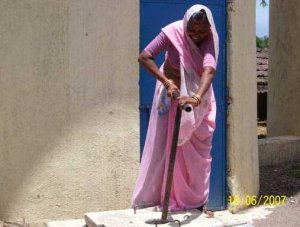
From Progress Report September 2006 - June 2007 by
People’s Learning Centre for Water & Sanitation, Bhavnagar
From 1997 to 2005, the Gujarat government implemented the 'Community Based Ghoga Regional Water Supply & Sanitation Project' in 80 villages in three blocks of Bhavnagar district in Saurashtra with financial aid from the Ducth The 80 villages from three blocks – Bhavnagar, Ghoga and Talaja were selected based on various parameters, the most crucial being their location in the Bhal region. The state government established an autonomous body Water And Sanitation Management Organisation (WASMO) to facilitate the implementation. In 1997, 80 villages After a pilot project in three villages, the scheme was implemented in 80 villages during 1997-2005 at a total cost of about Rs 60 crore. Netherland government also offered another Rs 12 crore for Water Resource Management (WRM) for developing local water resources.
It was in partnership of Netherland government, Gujarat government, village community and NGO Utthan with each having clear role and responsibility. While Netherland government provided finance, Gujarat government provided finance as well as technical support. Village community was expected to contribute 10 per cent of the cost, participate right from the conception to implementation and post project operation & maintenance. NGO Utthan undertook responsibility of community mobilization, capacity building and streamlining the implementation process as well as funds.
Utthan's 80-village project
Utthan approached each of 80 villages, beginning with an introduction followed by village meetings. After convincing people, a Gram Sabha was held to a pass resolution about community-based water schemes. Accordingly village water committees (VWC) were formed and participatory rural appraisals (PRA) and Base Line Surveys (BLS) were undertaken. After deciding on the option, the site selection was done e.g. which well or tank would be rejuvenated or where the underground tank or check dam would be located, where the Elevated Storage Reservoir (ESR) and sump would be built, where the stand posts and drinking water troughs for cattle would come up etc . Utthan helped the village community to file applications based on these basic inputs scheme. A team of geo-hydrologists from the Netherlands government and the Gujarat government surveyed the 80 villages for water resource development. Accordingly, new structures such as new wells or tanks as well as strengthening existing sources, recharging, check dams, percolation tanks etc were suggested as per the geo-hydrological conditions of each village.

From Progress Report September 2006 - June 2007 by
People’s Learning Centre for Water & Sanitation, Bhavnagar
After the schemes were sanctioned, the VWC Utthan and the state government signed an MoU for the scheme overseen by the Bhavnagar based Project Support Implementation Unit (PSIU) of the Netherlands Government. The PSIU called for tenders for works and awarded then to contractors based on bids. The VWCs kept vigilance on the contractor's work for which Utthan gave them technical training on design, materials and verification and testing. Hence the VWCs could object to contractors' shoddy work. At all stages, Utthan insisted and encouraged women's participation and hence women often were at forefront in overseeing the contractors' work.
During the drought year of 2001, villagers from Neswad - one of the project villages – needed work and suggested that instead of awarding the scheme's work to a contractor, the community would undertake the work . After Utthan's intervention, it was agreed to award on an experimental basis a water scheme worth Rs 14 lakh to the Neswad VWC. Mostly at women's initiative, a qualitative work was completed in time. Based on this experience, in about 45 villages, work was given to VWCs while 35 were done by contractors. And later the Gujarat government issued a GR that VWCs should be given works up to Rs 2 lakh as against previous system of Panchayat's tender system.
As per Utthan's assessment of work in these 80 villages, existing water sources were strengthened in 60 per cent of the villages, 10 per cent are getting water from Narmada pipeline project and 30 per cent schemes are closed due to various reasons. There are mainly management problems as most of the villages have not yet formed VWCs after the recent gram panchayat elections; where VWCs are formed, the new members are not aware of the various issues involved.
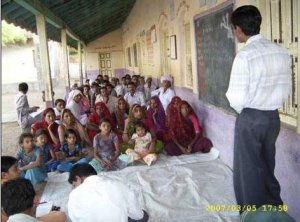
From Progress Report September 2006 - June 2007 by
People’s Learning Centre for Water & Sanitation, Bhavnagar
Genesis of PLC-Watsan
This assessment foregounded the fact that new VWCs, constituted every five years after panchayat elections, needed fresh training. For these 80 villages, 4-5 members out 12 member VWC will require training i.e. some 400 persons in some 3-4 training sessions.
There was the felt need for a Common Management Support Unit (CMSU) – a WASMO unit (government NGO) carried out surveys and exchanged findings for cooperation in capacity building of the VWCs with Utthan.
As a result, in 2005 the Utthan Bhavanagar unit a started People's Learning Centre for Water and Sanitation (PLC-Watsan)) in 2006 with a vision "to enable communities to recognize their basic right to have access to safe, adequate, equitable and sustainable drinking water supply, affordable sanitation facilities for hygiene promotion and lead them towards self-reliance through gender, just, participatory and community owned systems”
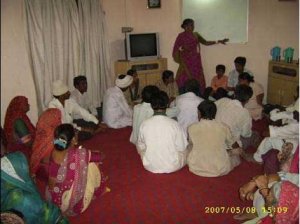
From Progress Report September 2006 - June 2007 by
People’s Learning Centre for Water & Sanitation, Bhavnagar
Utthan, which also set up two other PLCs in Rajula in Amreli district and Limkheda in Panchmahal district of Gujarat, declared the "PLC will have a multilateral approach for learning. It would serve as a platform for various stakeholders to share their experiences and learning, Developing and conducting need based and locale specific capacity building programs on drinking water and sanitation, the PLC will inculcate and disseminate lessons learnt. The PLC will as well focus upon intensive research and documentation to influence policies”.
The PLC-Watsan trainers' capacities were enhanced to take forward the action plan that involved different training modules focusing upon five major aspects i.e. i) Pre-Construction Module ii) Developing the Design and Proposal for a water and sanitation system Module iii) Post Construction Module iv) School sanitation Module v) Hygiene Promotion Module.
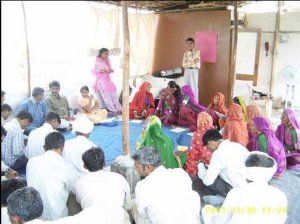
From Progress Report September 2006 - June 2007 by
People’s Learning Centre for Water & Sanitation, Bhavnagar
Two years of PLC-Watsan
During 2006-2008, PLC-Watsan carried out 7-8 workshops for about 400 social workers and VWC members, held 4 block level VWC members' conference for experience sharing and learning and organized 6 exposure visits of VWC members to water projects in other states. PLC-Watsan gives 9 types of trainings to VWC members and also facilitates advocacy networks, information dissemination, knowledge exchange, experience sharing and above all works on gender mainstreaming.
A typical plan of training programme for social workers and VWCs is as follows:
| Aspects | Methodology | Outputs |
| Expectations of the participants from the training | Questions and answers | To begin with, the participants understood the importance of forming a Water Committee |
| Discussion on the local level water and sanitation issues, reasons and impact | Group Discussions – small and large | The participants made efforts to understand the role of each member of the Water Committee |
| Importance of the Government's Resolution (GR) on Water Committees and key aspects that the participants must take into account while forming a Water Committee | Presentations | Clarifications about the various government schemes were provided |
| Discussion on the role of women in the Water Committees | Lectures | Importance of people's contribution and efforts made by a few of the participants were shared |
| Roles and Responsibilities and the various tasks of a Water Committee | Games and exercises | An all women's Water Committee shared their experiences that helped clarify the role of women in a Water Committee |
| Administrative aspects and the role of the secretary in the functioning of the Water Committee | Songs | -- |
| Role of the supporting NGO to the Water Committee | -- | -- |
| Different government programmes focused upon improving the water and sanitation aspects | -- | -- |
| Planning of the future action plan | -- | -- |
-Drawn from PLC- Watsan's Reports
Over next 2 years, PLC proposes to scale up such capacity-building programmes by spreading out and developing area wise resource persons who will train VWC members in their area. The PLC expects to develop 3 Area Resource Groups (ARG) in 3 blocks of Bhavnagar. Later each district will have District Resource Group (DRG). At the end of two years, it is expected that 100 applications for village water schemes should reach the government. The activities out of Bhavangar district will be mainly undertaken by the local partners with PLC-Watsan functionaries as resource persons. As for the follow up after the interventions, Sangitaben of PLC-Watsan said that PLC-Watsan asks local NGO partner for the feedback.
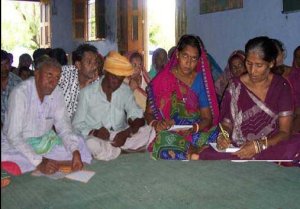
From Progress Report September 2006 - June 2007 by
People’s Learning Centre for Water & Sanitation, Bhavnagar
Post-project Survey
Currently, the PLC-Watsan has commissioned an independent assessment of the 80 villages. The first round of survey of 24 villages revealed the following preliminary observations. Twelve of the 24 schemes had stopped operating. However, PLC's earlier assessment was that in some 45-50 villages the scheme was operational and 30-35 schemes faced problems i.e. a failure rate of about 25-30 per cent as against 50 per cent as per above preliminary observation. And the reasons given by the villagers for the closure were as follows:
- In Village Nathugad (Block-Ghoga), the Mahi pipeline scheme never functioned as the Elevated Storage Reservoir (ESR) was too low to distribute water.
- Village Suraka (Bhavnagar) got Mahi pipeline water supply in 2005 but has been closed for 3 years because of unpaid water bill of Rs 18000. And villagers wish it to be cleared by "some organization or local MLA”! (Still want Mai Baap Sarakar to salvage the situation!)
- Karela (Ghoga) water scheme has been inoperational is closed for last two years because of misappropriation of funds.
- Bhavanipur (Ghoga) scheme closed down because the motor burned down.
- Walespur (Ghoga) scheme closed for 2 years because water charges were not paid and pipelines broke.
- Rajpara Khara (Ghoga) has local well water scheme but no water at stand post. The ESR tank is tilting and the sump is full of filth .
- Vavadi (Ghoga) has a borewell but because of poor quality of pipelines, there is no water at the stand posts. The VWC too is not ready to take responsibility due to shoddy work.
- Pithalpur (Ghoga) scheme has been inoperational for 2 years as motor got stuck in the borewell.
- Malpar (Ghoga) local well is closed and Mahi pipeline charges are pending.
- Ghoga has five local wells and one tank but inadequate pipelines. The village gets water once every 2-3 weeks!! Only 50 per cent of the villagers have paid up for supply of Mahi water.
- Mandva (Talaja) scheme of borewell water does not work because of failure in administration; some stand posts are dismantled or taps are removed at the stand posts.
- In Khadadpar (Talaja) scheme has been inoperational for the last one year as the motor fell into the bore well.
Out of 24 villages surveyed, about 50 per cent of the villages opted for Mahi-Narmada pipeline water supply while other 50 per cent opted for developing local well water supply. This survey also shows that rate of failure is higher for local well water supply than for Mahi-Narmada pipeline scheme. However, this observation differs from PLC's earlier assessment that existing water sources were strengthened in 60 per cent of these 80 villages, the Narmada pipeline water was taken in only 10 per cent while 30 per cent schemes were closed. Since above observation is based on 30 per cent sample (24 out of 80 villages), the final picture may turn out to be different.
Learning from PLC's experience
The reasons for the failure of the drinking water schemes are mainly due to inefficient management compounded by the fact that most of the villages have not yet formed VWC after the recent gram panchayat elections. "Elections bring in factional politics which impacts the village unity. After elections, panchayat members change which affects the water scheme"says Pravinbhai Bhikadia, Programme Coordinator of PLC. Another major reason is the villagers' unwillingness to pay. In Neswad village of Ghoga block, VWC members physically try to stop people who have not paid from filling water at the stand posts. While some still defy and draw water, the message is driven that water is not for free. By and large there is no misappropriation of funds as the VWC bank account is operated by three signatories and one of them is a woman member, observes Pravinbhai.
The reasons for the failure of the drinking water schemes are mainly due to inefficient management compounded by the fact that most of the villages have not yet formed VWC after the recent gram panchayat elections. "Elections bring in factional politics which impacts the village unity. After elections, panchayat members change which affects the water scheme"says Pravinbhai Bhikadia, Programme Coordinator of PLC. Another major reason is the villagers' unwillingness to pay. In Neswad village of Ghoga block, VWC members physically try to stop people who have not paid from filling water at the stand posts. While some still defy and draw water, the message is driven that water is not for free. By and large there is no misappropriation of funds as the VWC bank account is operated by three signatories and one of them is a woman member, observes Pravinbhai.
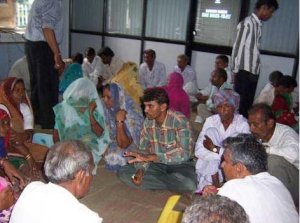
From Progress Report September 2006 - June 2007 by
People’s Learning Centre for Water & Sanitation, Bhavnagar
While decentralised solutions are ideal, the villagers have to take the responsibility of setting it up with government and other agency's facilitation/intervention/support and then running it independently. However, villagers are not aware of the issue nor the government schemes/support and conditions for the schemes and and their role in it. The PLC Watsan has identified this need for people's learning and since last two years has been imparting training in various aspects needed for decentralised solution. It is a very long drawn process and hence one should be careful about expectation of the success. All villagers do not act immediately on knowledge gained at the training programme. Besides, there are a lot of different dynamics at play which have to be factored in. However, PLC's model is worth emulating.
Entire PLC-Watsan professional team has been working for over a decade with Utthan on this 80-village project and their hands-on experience has given them an assessment about the need for learning and sharing by the communities. However, a six-member team can not possibly meet the vast latent demand for people's learning in Bhavnagar district itself. Perhaps, the concept of Area Resource Groups and District Resource Group could create the required cadre of trainers.
Field Notes from Village Boda Observation: Bhagwanbhai alone was very vocal but others too allowed his f leadership. He can be developed into an Area Resource Person as envisaged by PLC. One such dynamic person can move things towards transformation. Dahiben alone spoke when women were prodded to give their views. But on the sidelines of the meeting, women spoke out enthusiastically. |
| Field Notes from Odha Summer mornings are relaxed in Odha as there isn't much work in the fields. The main livelihood here is rainfed agriculture and livestock rearing .In the walled courtyard of Kuwarben's decent house, it was still cool and pleasant . Kuwarben sat with other veiled women a little away from the men. Out of 15-20 villagers, only three VWC members were present. On behalf of villagers, Dharamsibhai alone spoke in certain terms. "There is water in the well till Makar Sankranti but it is saline and if used for irrigation, the land needs salinity reduction treatment"says Dharamsibhai. Villagers have been drinking this water with 2500 TDS. But just about month ago, it started getting Mahi water for 7-8 hours on alternate days. At least there is drinking water now. Last year Sarpanch Lavjibhai, Dharamsibhai and four other VWC members attended three training programmes held at Mahuva by the PLC. None of the four VWC women members attended these training programmes. "We got valuable guidance about our own issues"says Lavjibhai. "We got to know about value of the clean water. Frankly, we did not know till then that what we have been drinking was not water but poison,"says Dharamsibhai. "Here we got to know about the community-based water schemes, how to plan it, how to raise contribution, how to involve women etc. For the first time we became aware of our health issues."Yet women still do not come due to 'maryada'. Odha paid Rs 1.60 lakh - 10 percent contribution as required under Swajaldhara, raising this amount from the villagers as per each one's capacity instead of imposing a particular amount. . Now work on an ESR and sump is underway. However, the village is quite inspired to take up local water resource development and put up a proposal for a check dam to DRDA. Under Saurashtra Jaldhara Yojana, a percolation tank on 30 acre land is proposed. This would recharge wells around it and also provide water for the cattle. When asked what would they do in case of any technical problem, the villagers said they would call government technicians, which indicates heavy dependence on the administration rather than learning some basic technical things and ask PLC for the guidance. Under the total sanitation scheme, 10 per cent households have made soak pits and 30 per cent have constructed latrines. Because of high fluoride content in drinking water, there are many incidences of stones, denture spots and skin diseases besides other water borne diseases like cholera, malaria, diarrhea, dysentery etc. A PHC run by the district panchayat has been closed down. So people have to travel to Mahuva town for treatment. Observation: Dharamsibhai appeared to have leadership quality while panchayat and VWC members do not seem to be taking much interest. Even women still do not participate. Just about three training programmes attended by four VWC members do not drive people into action. It needs far more follow up till a critical mass is gathered to galvanise people into action. |
| Field Notes from Neswad On the hot summer afternoon, people were generally indoors at Neswad which was one of 80 project villages. This village the state government to take important decisions in favour of the communities in constructing and undertaking the water schemes. (can crosslink/hyperlink here to main story details about neswad) The women of Neswad are aware and savvy, having attended various training programmes held by the PLC. Even after having been awarded tha the scheme work, the local Sarpanch was toying with the idea of using JCB machines to complete the work.However, the women opposed this idea as it would deprive them of their daily wage earnings and rallied villagers' support against using machines. Ultimately the Sarpanch backed down. Mongiben who underwent pre-construction training knew about materials and proportions. She found something wrong with the measurements of tank during construction and also with proportion of cement. She immediately informed VWC which in turn got panchayat to make amends. Under this scheme, a check dam was constructed to recharge nearby wells. An overhead tank, sump, five standposts, cattle troughs, washing place, soakpits were also constructed. Because of the recharge, now fluoride content in well water has come down to normal levels. It has been decided to raise Rs 30 per month per head towards O & M but 30 per cent of the households do not pay. So VWC members especially women keep vigil at the stand post and stop non-payers from taking water. Some comply but some defy too, says a VWC member. After the Panchayat election, a new VWC has not been formed and the old one contines.. There are few diamond cutting units in this village too. Many youngsters work here for 10 hours for a meager Rs 2.40-4 per diamond which earns them about Rs 2000 per month but results in health problems like backaches, weak eyesight and respiratory problems. During the holidays, even school going boys are sent for diamond cutting work . |